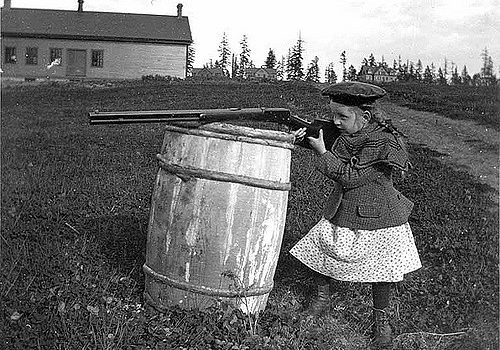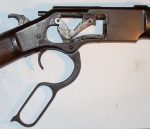To borrow a phrase from a popular television series, “Winter is coming.”
By the time you read this, the Leftists in Congress may well have passed, and their puppet in the White House will have signed, a new bill restricting the production, sale, and ownership of so-called ‘Assault Weapons’. By ‘Assault Weapons’ they mean America’s most popular semi-automatic rifles, used for recreational shooting, competition, hunting, and home defense. That none of these meet the textbook definition of ‘assault weapon’ means less than nothing to them. Nor does the fact that the new law will have absolutely no effect on crime. All Leftists care to know about firearms is that an armed populace is a roadblock on their way to absolute power.
The Assault Weapons Ban of 1994 prohibited the manufacture of a long list of semi-auto rifles and shotguns as well as ammunition magazines holding more than 10 rounds. Many common civilian firearms were designed around detachable 12-, 20-, and 30-round magazines. What had been perfectly legal ‘normal’ or ‘full-capacity’ magazines became, with the stroke of a pen, prohibited ‘high-capacity’ magazines.
At the time, getting 52 votes in the Senate meant grandfathering existing guns and adding a sunset clause. When the ban expired in 2004, gun owners and Constitutional scholars alike gave sighs of relief. But the pending bill will include neither grandfathering nor a sunset clause. Once the law is passed, it will legally be “game over” for our black rifles.
Left-wing politicians and the media portray Evil Black Rifles (EBRs) as easily converted into full-auto machine guns, and many uninformed people believe them. A new assault weapons ban (AWB) will start with EBRs, but all self-loading rifles, pistols and shotguns may well be included. What the Leftists can’t pass as laws will be pushed through as executive orders.
The irony is that only law-abiding citizens will be affected. Career criminals, so beloved of the Left, would be exempt from registration and taxation. Because felons can’t legally own firearms, forcing them to register guns would violate their Fifth Amendment rights.
The most viable alternative to the Evil Black Rifle may be the all-American lever action. These ‘cowboy rifles’ are handy, don’t have features that scare Liberals like detachable magazines or flash hiders, easy to operate and surprisingly versatile. So what if they aren’t 21st-century technology? As Robert Heinlein observed in Starship Troopers (a great book made into a mediocre film), “There are no dangerous weapons; there are only dangerous men.”
Evolution of the Lever Action
The Civil War Henry repeater was the assault rifle of its day. Like its modern EBR cousins it was fast-firing, held a lot of cartridges, and was less powerful than the standard battle rifle of its time. Southerners called the 16-shot Henry “that damned Yankee rifle that can be loaded on Sunday and fired all week”. Ammunition was a rimfire round, much like a scaled-up .22 Long Rifle. Cartridges of the World states that the .44 Henry Flat was loaded with a 200-grain bullet and 26 to 28 grains of black powder (a .44-28 in period parlance). This generated about 1100 fps and 568 foot-pounds of energy.
Figure 1: 1860 Henry
Repeaters were hated by elderly officers like General Ripley, the head of the Ordnance Department. Born in 1794 and raised with flintlocks, Ripley feared that breech-loaders firing metallic cartridges would encourage soldiers to waste ammunition. Nevertheless, Henrys were loved by the troops, many of whom purchased them out of their own pockets. They proved themselves in actions like the 1864 Battle of Franklin. The Spencer, a very different design with its tubular magazine in the buttstock instead of under the barrel, was its main competitor. Spencer replicas are available, but can be dismissed as an evolutionary dead end.
Henry rifless were made with either a brass or iron frame (replicas come in brass or steel; the new Henry rifle company makes replicas as well as a modern design that shares little with originals but the name). Civil War Henrys load from the front of the tube, and you have to move your weak hand out of the way of the magazine follower as you shoot. The ‘Yellow Boy’ 1866 Winchester was basically the same gun, improved by factory manager Nelson King with a gate allowing reloading from the side of the receiver. Most were still chambered for the .44 Henry rimfire, but the last lot were for a center-fire version. Ballistics were identical.
Seven years later Winchester finally perfected the Henry in their Model 1873, celebrated as ‘the gun that won the West’. It’s one of the few rifles featured in its own motion picture: Winchester ‘73, starring Jimmy Stewart. What really won over prospective buyers a century and a half ago was firepower, coupled with the fact that the new rifle came in the same .44-40 caliber as the equally-new Colt Single-Action Army. Packing just one type of ammunition for both rifle and revolver made as much sense then as it does today, and for the same reason.
Figure 2: Winchester 1873 Locking System
Those early lever actions were limited pressure-wise by their toggle-link locking system. Jointed in the middle, it works much like the knuckle in your finger, bending to eject and reload, then straightening when a cartridge is chambered and ready to fire. They could handle cartridges like the .44-40, which pushed the same bullet as the Henry at 1245 fps for 688 foot-pounds of energy. Standard barrels were 20 or 24 inches. Custom guns as short as 12 inches were available, and there was even a full-stocked 30-inch ‘musket’ with bayonet. The 1873 was also eventually offered in .38-40 and .32-20. A few were made in .22 rimfire. It was so popular it continued in production for 50 years, long after the introduction of Browning’s lighter and stronger Model 1892. Even today, many Cowboy Action shooters prefer the 1873. Why?
The ’73 may be weak by modern standards, but it’s smooth. It can pour out as many as 15 aimed shots per minute. Semiautos may cycle faster, but then only hits count. Using the ‘shoot one, load one’ technique many aficionados prefer, one can maintain a pretty steady stream of lead. At the Battle of Plevna in 1877, Turkish troops, some armed with Winchester repeaters, held off a Russian force that outnumbered them 5-1.
ARs or AKs might have done better, but black rifles were not available in 1877. They might be equally hard to find in 2022. At least the ’73 has a ‘tacticool’ dust cover over the open receiver top!
One expert characterizes the 1873 as “a 150-yard rifle chambered for a dinky little handgun cartridge” capable of 3-inch groups at 100. That’s worse than many ARs but better than some AKs. The ’73 will do the job on deer or hogs at woods ranges, in for most home-defense scenarios. No less an institution than the late Jeff Cooper’s Gunsite now teaches defensive shooting built around leverguns and single-action revolvers.
Carbine-length ‘73s typically have 10-round magazines, rifles, 14. Best practice as taught revolves around the ‘shoot one, load one’ method and a butt cuff holding spare rounds. I don’t actually own a Model 1873 (yet), but I am told that if you do shoot yours dry the brass cartridge lifter makes it faster and easier to single-load in an emergency than the solid-top Marlins or later Winchesters like the 1892.
Jonathan Browning’s 1892 Winchester is stronger than its older stablemates. Like the 1886, the ’92 uses two metal blocks that slide up and down in slots on either side of the breech bolt. It was lighter than the ’73, but not quite as butter-smooth in action. By the time production ended in 1941, Winchester churned out over a million Model 92s.
Figure 3: 1892 Winchester and Colt Single-Action Army
John Wayne carried an 1892 Winchester as the Ringo Kid in the 1939 version of Stagecoach and in other film roles. Some were modified with a larger lever loop, allowing the shooter to cock the rifle one-handed by spinning it. The large loop was carried over in 1958’s The Rifleman. Chuck Conner’s guns also had a set screw that tripped the trigger, allowing him to empty the entire magazine in 5 seconds. This made great television, but, like fanning the hammer of a sixgun, it has little practical application.
Steve McQueen’s 1892 Winchester “mare’s leg” on Wanted: Dead or Alive was shortened at both ends so he could carry it like a pistol. Josh Randall’s gun impressed viewers enough that several companies now make similar versions. Again, the practicality is questionable.
Prices on vintage Winchesters with bores unscarred by black powder and corrosive primers reach into the stratosphere. Clones are more affordable, but you can still pay upwards of $1000 new, a little less for a clean used example. Calibers include .45 Colt (never available in the originals), .44 and .357 Magnums, .44 and .38 Special (also modern), .44-40, .38-40 and .32-20. Winchester did make a few ‘94s in pistol calibers, but I see no advantage to the extra weight of the longer receiver.
Rossi offers an 1892 clone which sells for considerably less than Miroku/Winchesters or Ubertis. Copies of the ’92 produced in Spain had been popular throughout Latin America since the 20s, so it is no surprise that Rossi tapped ito the market. They began manufacturing their Puma carbine in Brazil in 1976. Currently it is available in .357.38 Special, .44 Magnum, .45 Colt and .454 Casull. This last offering is a real tribute to the basic strength of Browning’s design. It generates about three times the pressure of the .44-40 and eighty percent more than Dirty Harry’s .44 Magnum. Rossi carbines have a so-so reputation. Fit, finish and performance seem to vary from gun to gun. Accuracy is on a par with the average AK. Those fortunate enough to have good ones swear by them; others swear at them.
Some manufacturers offer the 92 in a takedown version, which makes a great backpack or truck gun. Taylor’s Chiappa Alaskan, equipped with Skinner express sights, is especially intriguing. It sports a larger-than-standard lever and comes in your choice of nickel and a tactical matte black. I have yet to see one up close, but published reviews suggest accuracy will be on a par with the Rossi. At nearly $2,000, it’s not something I’m going to order on a whim. Chiappa also offers full-size ’92s and replicas of Josh Randall’s ‘mare’s leg’ at prices comparable to other Italian-made carbines.
(To be concluded tomorrow, in Part 2.)












